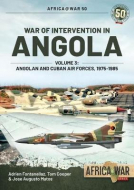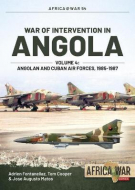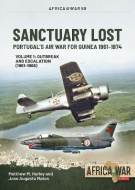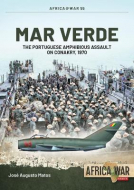
- Agriculture
- Architecture & Design
- Arts & Photography
- Biography
- Business
- Calendars and Diaries
- Childrens (All)
- Childrens (Illustrated)
- Childrens (Picture flats)
- Childrens (Te Reo)
- Classics
- Cooking, Food & Drink
- Craft & Hobbies
- Design (Art / Graphics)
- Design (Interiors)
- Education
- Fashion
- Fiction & Literature
- Fiction - Young Adult
- Gift Ideas
- Health & Wellbeing
- History
- Home & Garden
- Humour & Gift
- Instead of a Card Poems
- Military
- Music
- New Zealand
- NZ (History)
- NZ (Landscapes)
- NZ (Pictorial)
- Poetry
- Reference
- Religion & Faith
- Science & Nature
- Sport & Recreation
- Stationery
- Taschen : 40th Anniversary Edition
- Taschen : BA Basic Art
- Taschen : BU Bibliotheca Universalis
- Te Reo Māori
- Transport
- Travel
Jose Matos (4)
|
War of Intervention in Angola Volume 3 (Africa@War 50)
ISBN: 9781913118617 Authors: Adrien Fontanellaz, Jose Matos, Tom Cooper Publisher: Helion & Company War of Intervention in Angola, Volume 3 covers the air warfare during the II Angolan War - fought 1975-1992 - through narrating the emergence and operational hi... War of Intervention in Angola, Volume 3 covers the air warfare during the II Angolan War - fought 1975-1992 - through narrating the emergence and operational history of the Angolan Air Force and Air Defence Force (FAPA/DAA) as told by Angolan and Cuban sources. Most accounts of this conflict - better known in the West as the 'Border War' or the 'Bush War', as named by its South African participants - tend to find the operations by the FAPA/DAA barely worth mentioning. A handful of published histories mention two of its MiG-21s claimed as shot down by Dassault Mirage F.1 interceptors of the South African Air Force (SAAF) in 1981 and 1982, and at least something about the activities of its MiG-23 interceptors during the battles of the 1987-1988 period. Bind: paperback Pages: 72 Dimensions: 210 x 297 mm Publication Date: 23-11-2020 |
$49.99 |
|
|
War of Intervention in Angola: Volume 4 (Africa@War 54)
ISBN: 9781914059254 Authors: Adrien Fontanellaz, Tom Cooper, Jose Matos Publisher: Helion & Company War of Intervention in Angola, Volume 4 continues the coverage of the operational history of the Angolan Air Force and Air Defence Force (FAPA/DAA) as told by A... War of Intervention in Angola, Volume 4 continues the coverage of the operational history of the Angolan Air Force and Air Defence Force (FAPA/DAA) as told by Angolan and Cuban sources, in the period 1985-1988. Many accounts of this conflict - better known in the West as the 'Border War' or the 'Bush War', as named by its South African participants - consider the operations of the FAPA/DAA barely worth commentary. At most, they mention a few air combats involving Mirage F.1 interceptors of the South African Air Force (SAAF) in 1987 and 1988, and perhaps a little about the activity of the FAPA/DAA's MiG-23s. However, a closer study of Angolan and Cuban sources reveals an entirely different image of the air war over Angola in the 1980s: indeed, it reveals the extent to which the flow of the entire war was dictated by the availability - or the lack - of air power. These issues strongly influenced the planning and conduct of operations by the commanders of the Angolan and Cuban forces. Based on extensive research with the help of Angolan and Cuban sources, War of Intervention in Angola, Volume 4, traces the Angolan and Cuban application of air power between 1985-1988 - during which it came of age - and the capabilities, intentions, and the combat operations of the air forces. The volume is illustrated with 100 rarely seen photographs, half a dozen maps and 15 color profiles, and provides a unique source of reference on this subject. Bind: paperback Pages: 80 Dimensions: 210 x 297 mm Publication Date: 15-07-2021 |
$49.99 |
|
|
Sanctuary Lost (Africa@War 59)
ISBN: 9781914059995 Authors: Jose Matos, Matthew Hurley Publisher: Helion & Company From 1963 to 1974, Portugal and its nationalist enemies fought an increasingly intense war for the independence of "Portuguese" Guinea, then a colony but now th... From 1963 to 1974, Portugal and its nationalist enemies fought an increasingly intense war for the independence of "Portuguese" Guinea, then a colony but now the Republic of Guinea-Bissau. For most of the conflict, Portugal enjoyed virtually unchallenged air supremacy, and increasingly based its strategy on this advantage. The Portuguese Air Force (Força Aérea Portuguesa, abbreviated FAP) consequently played a crucial role in the Guinean war. Indeed, throughout the conflict, the FAP - despite the many challenges it faced - proved to be the most effective and responsive military argument against the PAIGC, which was fighting for Guinea's independence. The air war for Guinea is unique for historians and analysts for several reasons. It was the first conflict in which a non-state irregular force deployed defensive missiles against an organized air force. Moreover, the degree to which Portugal relied on its air power was such that its effective neutralization doomed Lisbon's military strategy in the province. The FAP's unexpected combat losses initiated a cascade of effects that degraded in turn its own operational freedom and the effectiveness of the increasingly air-dependent surface forces, which felt that the war against the PAIGC was lost. The air war for Guinea thus represents a compelling illustration of the value - and vulnerabilities - of air power in a counter-insurgency context, as well as the negative impacts of over reliance on air supremacy. Volume 1 of Sanctuary Lost is extensively illustrated with photographs and specially commissioned color artworks. Bind: paperback Pages: 80 Dimensions: 210 x 297 mm Publication Date: 25-08-2022 |
$49.99 |
|
|
Mar Verde (Africa@War 55)
ISBN: 9781914377006 Author: Jose Matos Publisher: Helion & Company In the early hours of 22 November 1970, six Portuguese warships surrounded Conakry, the capital of the Republic of Guinea, on the West African coast. Taking adv... In the early hours of 22 November 1970, six Portuguese warships surrounded Conakry, the capital of the Republic of Guinea, on the West African coast. Taking advantage of the darkness of the night, a military force landed on the northern and southern coasts of the sleeping city. At the head of these men was a young Portuguese marine officer, Commander Alpoim Calvão, who had been appointed to command this secret operation, codenamed Green Sea - Mar Verde in Portuguese. The main objective of the invasion was to promote a coup d'état in the former French colony and overthrow the regime of President Sékou Touré, who supported the guerrillas of the PAIGC (African Party for the Independence of Guinea and Cape Verde), who were fighting for the independence of Portuguese Guinea. The invaders also sought to destroy the naval resources that the guerrillas and the Guinean navy had in the port of Conakry, capture the leader of the party, Amilcar Cabral, and rescue a group of Portuguese soldiers held in a PAIGC prison. The incursion would not have the expected success concerning the coup d'état, and Portugal would be condemned by international organizations for the invasion of a sovereign state, but this operation would remain in the memory of many as the most daring carried out during the colonial war in Africa, although the Portuguese regime never recognized its involvement. Bind: paperback Pages: 72 Dimensions: 210 x 297 mm Publication Date: 28-12-2021 |
$49.99 |






